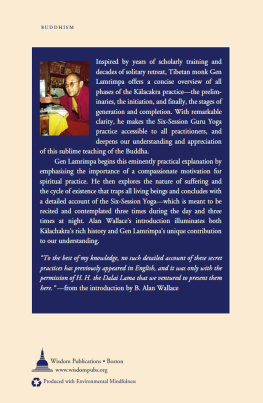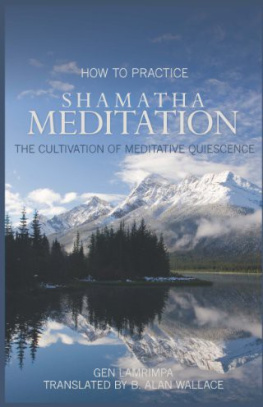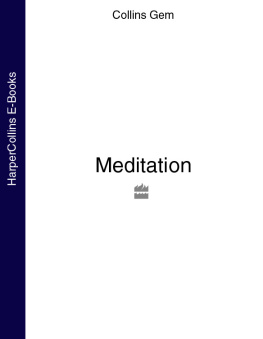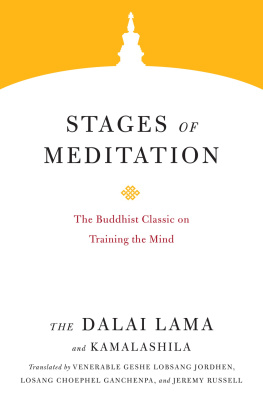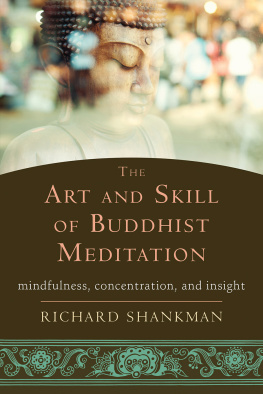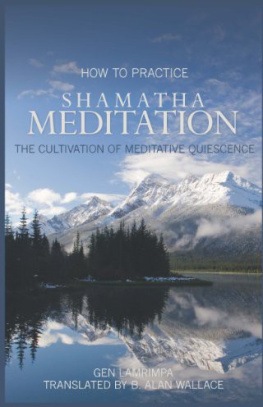
CALMING THE MIND
Tibetan Buddhist Teachings on
Cultivating Meditative Quiescence
CALMING THE MIND
Tibetan Buddhist Teachings on
Cultivating Meditative Quiescence
by Gen Lamrimpa (Ven. Jampal Tenzin)
Translated by B. Alan Wallace Edited by Hart Sprager



Contents
15
Unsuitable Motivations
Meaningful Motivations
Rebirth in the Form or Formless Realms
Liberation or Nirvana
Full Awakening
26
The Seven-Limb Puja
Building a Strong Foundation
Patience
Physical and Mental Obstacles
Potential Problems
Questions and Answers
41
Dwelling in a Favorable Environment
Reducing Desires and Developing Contentment
Rejecting a Multitude of Activities
Maintaining Pure Moral Discipline
Rejecting Thoughts of Desire for Sensual Objects
46
Preparation
The Actual Practice
Posture and Other Physical AspectsCounting the Breath
Questions and Answers
55
The First Fault: Laziness
Four Antidotes to Laziness
PliancyEnthusiasmAspirationFaith
The Interaction of the Four Antidotes
The Excellent Qualities of gamatha
Questions and Answers
64 67
Ascertaining the Specific Object of Meditation
The Second Fault: Forgetfulness
Establishing the Faultless Approach
Non-Discursive StabilityStrength of Clarity
The Third Fault: Laxity and Excitement
Maintaining Awareness of the Object
Antidotes to Laxity and Excitement
Dispelling a Faulty Approach
Duration of Sessions
Understanding That Arises from Reflection
Questions and Answers
86 89
The Practice When Either Laxity or Excitement Arises
The Definition of LaxityThe Definition of Excitement
Cultivating Vigilance That Recognizes Laxity and Excitement
The Fourth Fault: Non-Application
Antidotes for Non-Application
Definition of Intention
Additional Remedies for Laxity
Additional Remedies for Excitement
Recognizing the Causes of Laxity and Excitement
The Fifth Fault: Application
The Antidote for Application
Summary of the Five Faults and Eight Antidotes
Questions and Answers
113 115
The Nine Mental States
Differences Between the Nine Mental States
Questions and Answers
124 127
Accomplishing the Six Mental Powers
The Four Forms of Attention
133
The First and Last Antidote
Signs of Pliancy
Questions and Answers
138
Editor's Note
On January 6, 1988, at Cloud Mountain Retreat Center in Castle Rock, Washington, a group of twenty-four American dharma students and aspiring meditators began a gamatha retreat under the guiding hand of the Tibetan lama Gen Lamrimpa (the Venerable Jampal Tenzin). Some of us had made a three-month commitment to the practice, others of us were there for six months, and eight of us had committed ourselves to a year of meditation.
The body of this work is made up of the teachings on samatha Gen Lamrimpa gave during the first two weeks of the retreat. Those teachings were based on The Great Exposition of the Stages of the Path of Awakening by Tsong-kha-pa, who in turn based his teachings largely on Maitreya's text Examination of the Center and the Extremes.
Gen Lamrimpa included teachings by Asanga, namely his text called The Stages of the Listeners and the teachings of Santaraksita on The Essence of the Center. In addition he included teachings by Kamala ila-The States of Meditation, as well as the Compendium of Practices.
All of these teachers, as well as Santideva (whom Gen Lamrimpa quotes many times during the teachings), had perfectly attained gamatha during their lifetimes. At the time the teach ings were given, Gen Lamrimpa himself had twenty years' experience in gamatha and other meditative practices.
Transferring a teacher's words to paper is a relatively simple process but anyone who has experienced them must realize that the task of transferring to the printed page the vibrance and vitality present in the oral transmissions of a true master is next to impossible. Recognizing the impossibilities inherent in the task, all of us who have worked on this book have been motivated by the wish to pass on the essence of the teachings as well as the fundamentally unique quality of Gen Lamrimpa's presentation.
Throughout the teachings, Gen Lamrimpa began the day by speaking about motivation and the ways in which we, his students, could use the proper motivation to enhance our own internal processing of what we were about to hear. While what he said invariably enhanced our motivation, it sometimes seemed to have less than a direct relationship to the subject of gamatha. In that motivation is such an essential aspect of the practice, there was simply no way or reason to exclude those motivational moments from this edition. Four chapters-six, eight, ten and twelve-have been compiled from these daily teachings.
In his teachings, Gen Lamrimpa demonstrated his ability to present technical and often complicated material in a very uncomplicated and down-to-earth manner, and one of Alan Wallace's most outstanding qualities as a translator is his ability to transform that down-to-earth presentation into truly vernacular English while at the same time retaining the precision of the terminology and exactitude of the concepts being presented. It is my hope that the delicate balance they were able to create is evident in this rendering.
Finally, Gen Lamrimpa constantly emphasized the importance of continuity. At the same time, he took the liberty to digress from the formal outline of the presentation whenever such a digression enhanced the understanding of his students. Those digressions, which turned out to be shortcuts to the very heart of the matter, are included here just as they came up in the teachings.
It may be helpful for the reader to know a little about the basic daily routine we followed during the retreat. It was very much of an accordion-style schedule, devised so that each of us could function as much as possible on our own time clock. We awoke at five a.m. and went to sleep at around ten p.m. Except for hour-and-a-half breaks for breakfast, lunch and dinner, and short tea breaks throughout the day, we were urged to devote every waking minute to the practice. We were encouraged to maintain silence in all group areas, such as the dining hall, and to avoid contact with one another. We meditated individually in our own rooms. We started meditating in fifteen-minute sessions and took a fifteen-minute break between sessions, plus an occasional longer tea break as it seemed necessary. This format allowed for as many as eighteen quarterhour sessions throughout the day at the beginning of the retreat, a total of four and a half hours of actual meditation in what would ideally be a full day of practice.
As our proficiency in the practice increased, we extended the length of the sessions but held firm on the length of the break. At the end of a year of practice, some meditators were doing sessions that extended well beyond two hours. Thus, the time of formal meditation increased from the base four and a half hours to somewhere between six and twelve hours per day, depending on the individual's progress.
Next page


